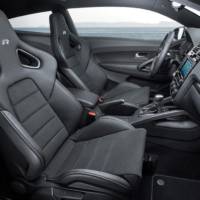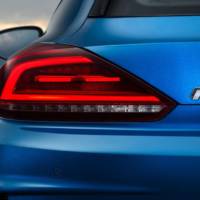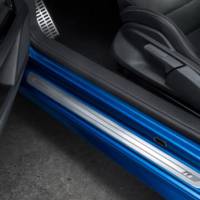In 1974, precisely 40 years ago, the first generation Scirocco made its debut at the Geneva International Motor Show. The coupé has since enriched the lives of all those motorists who love dynamic performance in an agile, confidently stylish and affordable sports car. Volkswagen now presents for the first time – once more in Geneva – the latest generation of the icon which has sold more than one million units.
The external characteristics of the Scirocco "2014" include its newly designed front and rear sections with redesigned H7 or bi-xenon headlights and LED rear lights. The rear and now swivelling VW logo was designed as a handle for opening the boot lid. The interior is equipped with sport seats and a leather sport steering wheel as standard, while the sports car also features new materials and colours. New technical features include the Dynaudio Excite sound system developed specifically for the Scirocco and the park steering assistant (ParkAssist). Also new on board as standard are auxiliary instruments (charge pressure, chronometer, engine oil temperature) which pay tribute to the original Scirocco.
Volkswagen produces the latest Scirocco at its Portuguese works close to Lisbon. The sports car will be launched initially in Europe from the middle of August. Shortly afterwards, the other high-volume markets such as China, Argentina, Turkey, Australia, Russia and South Korea will follow.
The design forms the visual basis for the overall sporty package of the Scirocco: with its unmistakable silhouette, the characteristic rear, the impressive front end and its appealing proportions the coupé also demonstrates visually that this car offers a high degree of agility and therefore provides driving fun. Like the first generation Scirocco, the third series of the sports car is also viewed as a stylistic icon. Reason enough to sharpen the design of the Scirocco carefully – although it can be recognised as "new" at an initial glance – in order to develop its character further.
The brand’s design DNA defines that the width of the vehicle in the front and rear areas is accentuated by using horizontal design features. The new Scirocco further reinforces this effect using completely newly designed LED rear lights and also a new boot lid. The trapezoidal contoured rear lights towards the centre of the vehicle with their C-shaped light contour now extend further into the boot lid which, in turn, is equipped with a horizontal light-refracting edge underneath the window. A new black diffuser matches this powerful and precise design, making the bumper appear to sit lower and the car as a whole flatter in its proportions. Practical: as stated above, the VW badge swings upwards when pressure is placed on the central axis in order to thus serve as a handle for opening the boot lid (which is protected against dirt). The number plate lighting also uses LED technology as standard.
The exterior of the Scirocco R. Traditionally independent design and upholstery elements characterise the top model in the series: the Scirocco R. This is equally true for the design of the front and rear aprons in motor sport look and for the wheels. In particular the three large, glossy black air inlets, the standard bi-xenon headlights, the LED daytime running lights and the LED indicators attract attention at the front. At the side, this includes the door mirror housings in "matt chrome", the side sill extensions with "R" styling and the brake callipers painted black with "R" logo. At the rear, the chrome tailpipes (respectively on the left and right) and the larger roof edge spoiler still belong to the insignia of the "R"; whereas the large air outlets in the bumper must be mentioned as new in the rear section. The standard 18-inch wheel trim for the Scirocco R was also redesigned. It is named "Cadiz"; optionally this alloy wheel can also be ordered as a 19-inch version.
Auxiliary instruments pay tribute to the original Scirocco. The new Scirocco has also been developed further in several areas inside. Thus, the optimised instrument panel trim on the passenger side which visually streamlines the dashboard with a striking horizontal edge is eye-catching. The air nozzle panels and the central panel around the navigation system with an aluminium-look are now flush-mounted in the instrument panel and thus accentuate the high-end quality of the interior. Like models such as the Golf GTI, the Scirocco is now also equipped with a new tubular-look instrument cluster; the instruments features new graphics and are smartly framed with an aluminium-look. The steering wheel design was also derived from the Golf GTI. Additionally, the three auxiliary instruments integrated above the centre console are included as a standard: charge pressure, chronometer and engine oil temperature. They serve as a tribute to the first Scirocco in which, dependent on the equipment version, two auxiliary instruments were installed lower down in the centre console. It goes without saying that the new Scirocco is also still equipped with standard features such as air conditioning, Hill Hold, electric windows and sport seats.
Sporty decor, materials and colours. There is now a storage compartment close to the handbrake lever which can be closed using a "sliding blind". It is no coincidence that the new decor – "checkered black" – in the central panel forms an optical bridge to the world of the Golf GTI. Last but not least, the seats have been redesigned with new materials. New are "Matthew" (a tartan design with titanium black seat surfaces), as well as "Greg" Alcantara which is available in the hues "Ceramique", "Deep Mocca" and "Titanium Black"; as well as "Vienna" leather in the colour variants "Ceramique", "Sioux" and "black in carbon style". Also new: the light upholstery trim "Ceramique" for the lower section of the dashboard, door trim panels and the centre console which is offered in addition to "black".
The interior of the Scirocco R. Similar to the exterior, the interior of the Scirocco R is marked by the hand of Volkswagen R GmbH. The individualised features include the "Race" seat covers with the "R" logo and decorative stitching in crystal grey, the black roofliner, decorative "Carbon Race" inlays, applications in glossy "Piano Black" (radio faceplate, multifunction leather sport steering wheel and door handles) and stainless steel pedals. The specific "R" instrument needles are traditionally blue and the aluminium door sill plates are complemented by an "R" logo.
The 2014 Scirocco will be supplied with state-of-the-art technology for Volkswagen’s four-cylinder engines. The perfected or new turbocharged direct injection engines all fulfil the stringent EU6 emissions standard; moreover they have been made up to 19 per cent more economical. Despite the reduced fuel consumption, all the engines demonstrate improved power. As standard, all new Scirocco up to a performance level of 162 kW / 220 PS also have a Stop/Start system as well as a battery regeneration mode. Except for the base engine (1.4 TSI, all Scirocco models can be combined with an optional dual-clutch gearbox (DSG).
Petrol engines have power outputs of between 125 PS and 280 PS. The performance range of the four TSI (turbo direct fuel injection engines) extends from 92 kW / 125 PS via 132 kW / 180 PS and 162 kW / 220 PS up to the new 206 kW / 280 PS powered exceptional engine of the Scirocco R. The 1.4 TSI with 125 PS is used for the first time by Volkswagen; the Scirocco base engine consumes 1.0 litres less per 100 km than its predecessor. Also, the 180 PS powered 2.0 TSI is new in the coupé line-up, following the 1.4 TSI with 118 kW / 160 PS in Europe. Although the new engine develops an additional 20 PS, it is some 0.6 litres per 100 km more economical than the 160 PS version. The adapted 2.0 TSI from the Golf GTI with 220 PS is also new in the coupé; a reduction in consumption of 1.4 litres per 100 km compared to its predecessor or 19 per cent.
Diesel engines develop 150 PS and 184 PS. The two Scirocco TDIs now achieve 110 kW / 150 PS and 135 kW / 184 PS. Both engines are extremely economical with 4.1 l/100 km (150 PS) or 4.3 l/100 km (184 PS). The reduction in consumption compared to the predecessor’s less powerful engines is 0.8 litres / 100 km for both TDIs.
Four TSIs and two TDIs. A summary of the engines with their performance data, performance increases and consumption values (6-speed manual gearbox) is shown below:
1.4 TSI: 92 kW / 125 PS (+ 3 PS); 5.4 l/100 km / 125 g/km CO2.
2.0 TSI: 132 kW / 180 PS (+ 20 PS); 6.0 l/100 km / 139 g/km CO2.
2.0 TSI: 162 kW / 220 PS (+ 10 PS); 6.0 l/100 km / 139 g/km CO2.
2.0 TSI: 206 kW / 280 PS (+ 15 PS); 8.0 l/100 km / 187 g/km CO2.
2.0 TDI: 110 kW / 150 PS (+ 10 PS); 4.1 l/100 km / 107 g/km CO2.
2.0 TDI: 135 kW / 184 PS (+ 7 PS); 4.3 l/100 km / 111 g/km CO2.
























